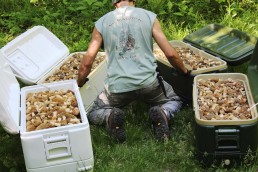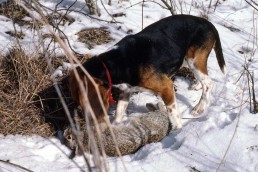Chasing the Mother Lode of Morels
SHARE THIS POST
My name is Alex Babich, and I am in love with morel mushroom hunting. Morels are wild, edible mushrooms that look like a sponge and taste like filet mignon. The rich, nutty, earthy flavor is undeniable, which is why every good chef loves to have a steady supply in spring, although very few can afford it.
Edible mushroom hunting has been one of the most popular traditions in the world for centuries. And there are a number of wild fungi that are safe and delicious. But here in the Midwest, the morel is king. For me, it all started long ago growing up, where my grandpa took me mushroom hunting in the Ukrainian forests. He taught me the different types of mushrooms and occasionally would remind me, “Every mushroom is edible—sometimes only once.”
Those words of wisdom have stuck in my head to this day. Since living only 50 miles from Chernobyl, after the nuclear disaster in 1986 we started filing paperwork to get out of the USSR. It was far from easy and took us five years, but we were finally granted permission to immigrate to Fort Wayne, Ind. Not knowing a word of English, we started a new life and I have to say that I am very grateful to live here.
It was in Indiana where I found my first morel, and after experiencing its amazing taste, my passion for hunting them quickly turned into an obsession. And if you ask my wife, the word “obsession” is too small to describe it now.
Come spring, most folks head out to enjoy a nice walk in the woods to brush off cabin fever and ultimately check their few coveted morel spots. While others, like myself, take it to the next level and travel with the morel season from southern states where they first appear, and up to the North. As a bonus, hunting in multiple states helps to maximize the bounty.
But part of the reason why morel hunting is so addictive is because their season only lasts a few weeks.
When the temperature starts warming up in March, morels begin to appear in California and Georgia. They then make an appearance up north. The Midwest’s season typically begins in April and May when the forests come to life with hunters hoping to score a few for their skillet to sauté. I have hunted all throughout the Midwest, and no matter how deep I hike, I always run into other hunters. Morels can be found in almost every state, with the exception of a few. And because these mushrooms love moisture, I watch the weather patterns pretty closely and concentrate on the areas with a good amount of rain.
Mushroom hunters are split into two categories: ground hunters and tree hunters. I started hunting for them as a ground hunter. This hunting involves a lot of hiking to cover a lot of land, and I only come out with a few morels. Treating them like gold nuggets, I carefully take them home, sauté them in butter, crawl into my most comfortable chair and enjoy every biter. That night when I go to bed I close my eyes and see sponge and revisit the finds I harvested that day.
Almost all hunters agree that they have had the same experience. As time went on, I became addicted to learning more about this elusive fungus and as a result I became a tree hunter. Morels can be found under a number of trees, including elm, ash, tulip poplar, sycamore, cottonwood and oak. Morels are the fruiting body of a mycelium web that lives underground and attaches itself to the root system of the tree. Although each state and tree preference varies, I usually adapt to the woods that I’m hunting in fairly quickly.
Are you enjoying this post?
You can be among the first to get the latest info on where to go, what to use and how to use it!
Morels appear when the ground temperature reaches 55 degrees. The first to come up are the black morels (Morchella angusticeps), although they are less common in some states. These are followed by gray morels, and sometimes these stay gray even as they mature, and, in other instances and weather permitting, turn into what my wife and I call a “grellow” and then yellow.
Some old-timers claim that morels pop from the ground, and at their typical size, seemed opposed to growing. We know personally that this is not true. Every season, we cover baby morels with leaves and return five days to a week later and pick the same morels that have grown much bigger. Sometimes the weather will stunt the growth of a morel and it will stay the same size and other times another hunter or deer or turkeys find our “stash.” But if all goes well, we’ll return to pick some giants.
I have done many morel-hunting seminars at sport shows and lake and cabin shows where people always ask me why there are not as many morels as there used to be. So many of those folks have stories to tell about the glory days. I believe because of the internet, the number of mushroom hunters keeps increasing drastically every season. Unfortunately, a lot of inexperienced hunters use plastic bags to collect morels and don’t allowing the mushrooms to breathe so they can release their spores back onto and into the floor of the woods. Many hunters will also pick every tiny morel they can find while digging in the leaves, crushing most and not giving them the chance to grow bigger and produce spores. It’s been determined that most morels don’t spore until around the tenth day of their life cycle. I tell folks at my seminars that too many hunters unknowingly damage some of their best spots. Again, there are so many morels hidden under the leaves that get stepped on and crushed. The best thing to do early in the season when the morels are small is to approach every potential spot with care, taking very few steps in and around the productive tree, pick what you want and then get out very carefully; if you can, return three to seven days later and hopefully pick more. Morels can be frozen or dried to preserve for later use. And if you have any questions, you are welcome to join our Facebook group Morchella Connection, where we share photos, stories, recipes and everything morel- mushroom related.
Mushroom hunters are just as elusive as their prey, with their spots kept secret and passed down like family heirlooms. In the mushroom-hunting world, I’m known as “The Mad Russian.” Not because I am mad, but because I am passionate. While hunting, I’ve come across bears, wolves, wild boar, bobcats, mountain lions, herds of elk, numerous snakes, ticks, and, of course, zillions of mosquitoes. Yet each year I still can’t wait for the arrival of spring to see what kind of mother lode I might come up on below.
One of my favorite things about mushroom hunting over the years is all the characters I’ve met with names like “Ninja Shroomer,” “Mushroom Whisperer,” “Morel Maniac,” “Shroom Doggy Dog,” “The Bear,” “Mushroom King,” “The Walrus” and “The Professor.” With all the crazy stories that I’ve heard it would be easy to create a great reality TV show about mushroom hunters, or simply “Funguys.” People would relate to it because both edible and poisonous mushrooms grow all over the world—you just have to know what you’re doing. With some knowledge, one could eat like a king, enjoying dishes with some of the best flavors God has created, or, with some bold ignorance, one could experience a very painful death.
Because the morel season is so short, hunting this fungus can be extremely competitive. There’s also more demand than supply, which makes them pretty expensive to buy for those who cook and aren’t outdoors types or those less lucky when afield or those who simply don’t want to deal with the ticks and mosquitoes. I have hunted morels from North Carolina all the way up to Alaska, but most seasons I spend the majority of my time here in the Midwest. In 2005, I won the large Morel Hunting Tournament held in Magnolia, Ill., a contest that attracts over 500 competitors from all over the U.S. Now, I enjoy designing and making some of the best mushroom-hunting products that we sell on our website. You will also find my booth set up at some of the biggest festivals in the Midwest where I connect with thousands of mushroom hunters.
Each spring, I get excited to have my kids in the woods with me. My 6-year-old daughter Ayla has quickly turned into a great picker, and I’m especially excited to be guiding my 2-year-old son Keenai into some nice patches this season. His favorite foods are already mushrooms and fish, so we will make him work for it. I am a huge advocate of taking kids mushroom hunting to pass on the tradition and to teach them something they will remember forever. Best of luck this spring, but remember, respect the nature and it will reward you.
For more information…
For more on morels, visit morelmushrooms.etsy.com or email mushroomgear@hotmail.com.
MWO
SHARE THIS POST
Did you enjoy this post?
You can be among the first to get the latest info on where to go, what to use and how to use it!
MWO
We believe being outdoors is good. With more than 1,000 articles each year, MidWest Outdoors magazine is all about sharing outdoor experiences with you—where to go, what to use and how to use it… whether you’re close to home or on that trip of a lifetime.



